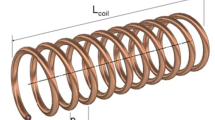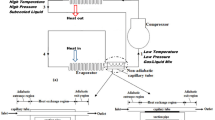Abstract
This work presents a numerical model to simulate refrigerant flow through capillary tubes, commonly used as expansion devices in refrigeration systems. The flow is divided in a single-phase region, where the refrigerant is in the subcooled liquid state, and a region of two-phase flow. The capillary tube is considered straight and horizontal. The flow is taken as one-dimensional and adiabatic. Steady-state condition is also assumed and the metastable flow phenomena are neglected. The two-fluid model, considering the hydrodynamic and thermal non-equilibrium between the liquid and vapor phases, is applied to the two-phase flow region. Comparisons are made with experimental measurements of the mass flow rate and pressure distribution along two capillary tubes working with refrigerant R-134a in different operating conditions. The results indicate that the present model provides a better estimation than the commonly employed homogeneous model. Some computational results referring to the quality, void fraction, velocities, and temperatures of each phase are presented and discussed.









Similar content being viewed by others
Abbreviations
- A :
-
Cross-sectional area of the tube, m2
- A d :
-
Surface area of the suspended particle, m2
- a i :
-
Interfacial area per unit volume, 1/m
- B d :
-
Volume of the suspended particle, m3
- C mv :
-
Virtual mass coefficient
- C fi :
-
Interfacial friction coefficient
- C D :
-
Drag coefficient
- C r :
-
Relaxation coefficient
- C :
-
Velocity of sound, m/s
- c p :
-
Specific heat capacity, J/(kg/K)
- D :
-
Internal diameter of the tube, m
- D C :
-
Internal diameter of inlet device, m
- d :
-
Mean bubble diameter, m
- d 0 :
-
Initial mean bubble diameter, m
- F LV :
-
Interfacial force per unit volume, N/m3
- F mv :
-
Virtual mass force per unit volume, N/m3
- F wk :
-
Wall friction force per unit volume to phase k, N/m3
- f :
-
Friction factor
- f B :
-
Two-phase flow region friction factor
- G :
-
Mass flux, kg/(m2 s)
- h :
-
Specific enthalpy, J/kg
- \( \hat{h}_{i} \) :
-
Interfacial heat transfer coefficient, W/m2 K
- K :
-
Pressure loss factor associated with the inlet device
- \( \hat{k} \) :
-
Thermal conductivity, W/(mk)
- L :
-
Tube length, m
- M :
-
Mach number
- \( \dot{m} \) :
-
Refrigerant mass flow rate, kg/s
- N :
-
Bubble number density, 1/m3
- Pr :
-
Prandtl number
- p :
-
Pressure, N/m2
- q i :
-
Interfacial heat flux, W/m2
- Re :
-
Reynolds number
- S 0 :
-
Initial slip between the phases
- T :
-
Temperature, K
- V :
-
Specific volume, m3/kg
- V :
-
Velocity, m/s
- x :
-
Vapor mass fraction (quality)
- z :
-
Axial distance, m
- α :
-
Superficial void fraction
- Γ :
-
Interfacial mass flux per unit volume, kg/(m3 s)
- ΔT sub :
-
Subcooling, K
- ε :
-
Tube wall roughness, μm
- η :
-
Wallis parameter for momentum flux due to phase change
- µ :
-
Dynamic viscosity, kg/(m s)
- ρ :
-
Density, kg/m3
- k = L, V:
-
Phase index, liquid and vapor respectively
- i:
-
Interface
- sat:
-
Saturation state
- ent:
-
Capillary tube inlet
- o:
-
Initial values
References
Agrawal N, Bhattacharyya S (2008) Homogeneous versus separated two-phase flow models: adiabatic capillary tube flow in a transcritical CO2 heat pump. Int J Therm Sci 47:1555–1562
Bansal PK, Xu BA (2003) Parametric study of refrigerant flow in non-adiabatic capillary tubes. Appl Therm Eng 23:397–408
Bolstad MM, Jordan RC (1948) Theory and use of the capillary tube expansion device. Refrig Eng 56:519–523 552
Carey VP (1992) Liquid-vapor phase-change phenomena. Hemisphere Publishing Corporation, New York
Chen ZH, Li RY, Lin S, Chen ZY (1990) A correlation for metastable flow of refrigerant 12 through capillary tubes. Part I. ASHRAE Trans 96:550–554
Churchill SW (1977) Friction factor equation span all fluid regimes. Chem Eng 84:91–92
Colburn AP (1933) A method for correlating forced convection heat transfer data and a comparison with fluid friction. Trans AIChE 29:174–210
Cooper L, Chu CK, Brisken WR (1957) Simple selection method for capillaries derived from physical flow conditions. Refrig Eng 65(7):37
Erth RA (1970) Two-phase flow in refrigeration capillary tubes: analysis and prediction. Ph.D. Thesis, Purdue University, USA
Fauske HK (1962) Contribution to the theory of two-phase one-component critical. Flow Argonne National Laboratory. ANL-6633, Argonne, USA
Fiorelli FAS, Silvares OM (2003) Capillary tube simulation with refrigerant mixtures flow using separated flow model. In: Proceedings of the 12th Brazilian congress of mechanical engineering, CD-ROM, São Paulo, SP, Brazil, pp 1–9
Ishii M, Mishima K (1984) Two-fluid model and hydrodynamic constitutive relations. Nucl Eng Des 82:107–126
Li RY, Lin RY, Chen ZH (1990) Numerical modeling of thermodynamic non-equilibrium flow of refrigerant through capillary tubes. ASHRAE Trans 96:542–549
Liang SM, Wong TN (2001) Numerical modeling of two-phase refrigerant flow through adiabatic capillary tubes. Appl Therm Eng 21:1035–1048
Lin S, Kwork CCK, Li RY, Chen ZH, Chen ZY (1991) Local frictional pressure drop during vaporization of R-12 through capillary tubes. Int J Multiph Flow 17(1):95–102
McLinden MO, Klein SA, Lemmon EW, Peskin AP (1998) Thermodynamic and transport properties of refrigerants and refrigerant mixtures—REFPROP Version 6.0. National Institute of Standards and Technology NIST
Melo C, Ferreira RTS, Boabaid Neto C, Gonçalves JM (1995) Experimentation and analysis of refrigerant flow through adiabatic capillary tubes. In: ASME Int. Mechanical Engineering Congress and Exposition, Heat Pumps and Refrigeration Systems, Design, Analysis and Applications, pp 19–30
Mezavila MM (1995) Simulation of refrigerant flow through nanadiabatic capillary tube. Master’s Thesis, Department of Mechanical Engineering, Federal University of Santa Catarina, Florianópolis, SC, Brazil
Mikol EP, Dudley JC (1964) A visual and photographic study of the inception of vaporization in adiabatic flow. J Basic Eng 257–264
Miropolskiy ZL, Shneyerova RI, Karamysheva AI (1970) Vapor void fraction in steam fluid mixture flowing in heated and unheated channels. In: International Heat Transfer Conference, vol. 5, Paris
Radovich NA, Moissis, R (1962) The transition from two-phase bubble flow to slug flow. Report no. 7-7633-22. Mechanical Department, MIT, Cambridge, MA
Richter HJ (1983) Separated two-phase flow model: application to critical two-phase flow. Int J Multiph Flow 9:511–530
Rowe PN, Henwood GA (1961) Drag forces in a hydraulic model of a fluidized bed—part I. Trans INSTN Chem ENGRS 39:43–54
Schwellnus CF, Shoukri M (1991) A two-fluid model for non-equilibrium two-phase critical discharge. Can J Chem Eng 69:188–197
Seixlack AL (1996) Modeling the two-phase flow through capillary tubes (in Portuguese). Ph.D. Thesis, Federal University of Santa Catarina, Florianópolis, SC, Brazil, 149 p
Seixlack AL, Barbazelli MR (2009) Numerical analysis of refrigerant flow along non-adiabatic capillary tubes using a two-fluid model. Appl Therm Eng 29:523–531
Seixlack AL, Navas RA (2006) Modeling of transient flow through capillary tube-suction line heat exchangers. In: Proceedings of the 13th international heat transfer conference—IHTC-13. ISBN: 1-56700-226-9, reference HEX-28, Sydney, NSW, Australia, pp 1–12
Solbrig CW, McFadden JH, Lyczkowski RW, Hughes ED (1978) Heat transfer and friction correlations required to describe steam-water behavior in nuclear safety studies. AIChE Symp Ser 174:100–128
Wallis GB (1969) One-dimensional two-phase flow. McGraw-Hill Book Company, USA
Whitaker S (1972) Forced convection heat transfer correlations for flow in pipes, past flat plates, single cylinders, single spheres and flow in packed beds and tube bundles. AIChE J 18:361–371
Wong TN, Ooi KT (1996) Adiabatic capillary tube expansion devices: a comparison of the homegeneous flow and the separated flows models. Appl Therm Eng 16(7):625–634
Wongwises S, Chan P (2000) Two-phase separated flow model of refrigerants flowing through capillary tubes. Int Commun Heat Mass Transf 27(3):343–356
Yang C, Bansal PK (2005) Numerical investigation of capillary tube-suction line heat exchanger performance. Appl Therm Eng 25:2014–2028
Zuber N (1964) On the dispersed two-phase flow on the laminar flow regime. Chem Eng Sci 19:897–917
Acknowledgments
This work was performed under a technical and scientific cooperation agreement between the Research Laboratories for Emerging Technologies in Cooling and Thermophysics of the Department of Mechanical Engineering of Federal University of Santa Catarina and EMBRACO. The support received from EMBRACO during the many stages of this research is gratefully acknowledged, with special recognition to Eng. José Lainor Driessen and Eng. Roberto Horn Pereira for their encouragement and assistance. Thanks also goes to Dr. Jader Riso Barbosa Jr. who helped during the preparation of the final version of this work.
Author information
Authors and Affiliations
Corresponding author
Additional information
Technical Editor: Jose Parise.
Rights and permissions
About this article
Cite this article
Seixlack, A.L., Prata, Á.T. & Melo, C. A two-fluid model for refrigerant flow through adiabatic capillary tubes. J Braz. Soc. Mech. Sci. Eng. 36, 1–12 (2014). https://doi.org/10.1007/s40430-013-0051-9
Received:
Accepted:
Published:
Issue Date:
DOI: https://doi.org/10.1007/s40430-013-0051-9




